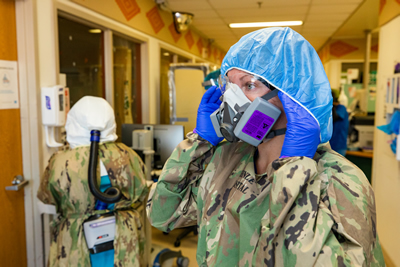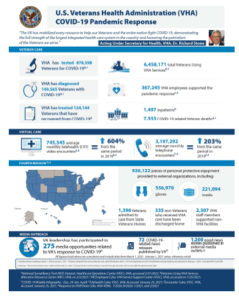
Navy Ensign Stephanie Buice, a registered nurse with the Rapid Rural Response Team, dons a bouffant cap before entering a patient’s room at Chinle, AZ, Comprehensive Health Care Facility last December. , Army photo by Spc. DeAndre Pierce
The usual missions of the VA and DoD are to provide healthcare for veterans, servicemembers, military families and retirees. The COVID-19 pandemic dramatically changed that. Whether called the Fourth Mission for the VA or whole-nation response for the DoD, federal medicine played a critical role in providing medical backup across the country for civilians.
WASHINGTON—Early in the COVID-19 pandemic, when the nation was reeling from the realization of what actually was occurring, the USNS Comfort entering New York Harbor was a symbol of hope for many.
That the ship ended up leaving a month later, having treated few patients, brought home another message: What was needed to combat the novel coronavirus pandemic was difficult to discern and hard to understand.
Less dramatic but just as important was what occurred at the end of 2020 and into 2021, when military and VA medical personnel traveled in droves to help combat the catastrophic outbreak of COVID-19 in tribal areas of the Southwest. At an unprecedented level, the VA and DoD played a critical role not only with their usual missions of caring for veterans, servicemembers, military families and retirees, but also by providing healthcare backup across the country to civilians.
That is codified as the “Fourth Mission” for the VA, and, in a recent report looking at the July 1, 2020, to Jan. 1, 2021, period of the pandemic, the authors wrote, “VHA continued its historic level of response to [Federal Emergency Management Agency] mission assignments under the Fourth Mission during this period,” adding that those included activities in community health systems, state veterans’ home, tribal health systems and local governments.
VA’s Fourth Mission exists to support humanitarian assistance to nonenrolled veterans, veterans with less-than-honorable discharges, first responders, the public and U.S. operations during national emergencies, including war, terrorist attacks, pandemics and natural disasters.
Overall, according to VHA leadership, Fourth Mission assignments for the second six months of the pandemic were similar to those at the beginning of the outbreak.
“All of these organizations experienced increased stress … due to the rise in COVID-19 cases,” according to the report. “Fourth Mission activities allowed VHA to ease that stress.”
VHA officials had set a goal to offer up to 20% of bed capacity to community COVID-19 patients, and VISNs were encouraged to offer those beds to needy communities, with primary focus on receipt of critical care patients. Even with that mission, the report emphasized that sustaining full access for the enrolled veteran population remained top priority.
“Multiple community health systems sustained elective surgical procedures despite sustained accelerated spread of COVID-19 in the community, leaving them with diminished capacity when the pandemic-driven surge in demand for inpatient care hit the community,” according to the recent review. In addition to aiding community hospitals, VHA staff played an outsized role in helping long term care communities protect residents from COVID-19 infection and providing backup when staff became ill.
VISNs reported providing staff supplements outside of their facility on 374 occasions during the time period, providing extra protective equipment 47 times, offering education 30 times, opening up bed capacity 28 times, bolstering testing resources 21 times, sharing supplies 45 times, making subject matter expertise available 47 times and making infection control backup available 31 times.
While all VISNs provided Fourth Mission backup, the review of VA pandemic response noted that VISN 22, the Desert Pacific Healthcare Network, was particularly active late last year.
In July and August, the VISN provided acute care capacity in the Arizona cities of Tucson and Phoenix. In December 2020, the VISN provided additional Fourth Mission support in Southern California.
“Simultaneously, VISN 22 deployed staff to the Navajo Nation Health System, while opening up acute care capacity in VAMCs for COVID-19 patients from IHS and Navajo health facilities,” according to the authors, who cited national Centers for Disease Control and Prevention data revealing a disproportionate impact of COVID-19 on Native Americans.
The report explained that most requests for health services assistance from tribal nations and the IHS were for clinical staff; insufficient resources or the lack of contracting support made it difficult for those groups to get the help they need.
“VHA responses were facilitated where existing relationships and agreements were in place between VHA facilities, VHA networks and tribal nations,” the report noted. “A baseline of periodic communications and coordination between VHA facilities and tribal nations has proven effective in facilitating early consultation. The existing relationships also streamlined communication so that requests for support were clearly defined and more quickly validated.”
Still, some VA officials told report authors that Fourth Mission efforts were challenged toward the end of 2020 by the surges in COVID-19 infections. “This was a challenge because it led to an increase in the demand for staffing, especially in California and the Southwest region.726 In response to the increased needs, VHA provided increased support,” according to the document, “For instance, to support the Oklahoma City VAMC, VHA deployed a mobile ICU and employees from other facilities to staff it.
It was during this time that VA opened 10 beds—five acute care and five intensive care—at the Carl T. Hayden VAMC in Phoenix. That facility also deployed 16 nurses to support Native Americans in hard-hit Arizona communities and four nurses to a community nursing home in Los Angeles. In addition, it provided supplies to the Navajo Nation and offered clinical expertise where needed in the region.
Enhanced Collaboration
Recommendations in the report suggested that development of a strategy for enhanced collaboration between the VA and tribal nations and HIS be considered, with a primary focus on strong local agreements supported by central collaboration with IHS.
According to the authors, that might include:
- Working with IHS, jointly to pursue legislative support and resources for collaboration within VHA modernization initiatives with the goal of enhancing health infrastructure, emergency response and tools for tribal nations.
- Considering development of a partnership engagement toolkit, including centrally developed tools for networks to build and sustain relationships with tribal nations and IHS facilities.
- Prioritizing establishment of local agreements with tribal nations and IHS facilities, including high reliability, patient safety programs, quality of care measurement and continuing education. Include utilization of the partnership engagement toolkit.
- Developing deployable teams of shared VA and IHS/tribal health personnel at select locations to actively engage in daily healthcare operations. This team would facilitate the collaboration within particular systems of care and VHA response under its Fourth Mission to tribal nations.
In terms of Fourth Mission appeals outside of the IHS/tribal health arena, the report pointed out, “Many such requests required response by clinical teams for on-site provision of care and consultation, for which VHA was often the only available source. Surges in hospitalization exceeded community capacity and generated urgent needs that were difficult to provide at alternate sites.”
In response, VHA was able to open critical care beds for transfers from multiple locations. “VHA’s mobile ICU assemblage proved effective as a medical-surgical inpatient platform and appears capable for critical care. However, the stresses of sustained response under Fourth Mission led to difficulty sourcing available staff for deployment,” the report noted.
In addition to sending Navy ships where needed, the DoD’s most visible role was in spearheading Operation Warp Speed, which helped develop COVID-19 vaccines in record time. The DoD’s contributions to OWS included managing contracts, building vaccine production facilities, enrolling participants in vaccine trials and more. The massive program coordinated with dozens of private companies such as pharmaceutical companies, medical supply vendors, vaccine raw material suppliers, and transportation providers.
More similar to the VA’s response, however, was mass deployment of the National Guard to aid community hospitals, virus testing sites and the IHS/tribal areas.
FEMA announced recently that federal funding for the National Guard to support the whole-of-America response to COVID-19 was extended. While the National Guard remains under the command and control of their respective governors and is funded by the DoD, FEMA has mission assigned DoD to fund Title 32 National Guard deployments to support state and territorial efforts in response to the pandemic.
It said National Guard troops have helped distribute food and PPE, supported contact tracing and testing, and their medical teams have supported direct patient care and now will assist with vaccine administration.
So far, FEMA has obligated $2.7 billion to the National Guard mission, although it advises that Title 32 is rarely used for disaster response. Usually the states pay for those activities. As of Dec. 7, about 18,000 National Guard troops were deployed under Title 32.
Earlier in the pandemic, active and reserve components of doctors, nurses and medical technicians were mobilized to two ships and numerous expeditionary field hospitals around the country to support local healthcare systems.
The response has become more targeted recently. For example, Naval Medical Center Portsmouth’s Rapid Rural Response Team (RRRT) recently deployed to the Chinle Comprehensive Care Facility in Albuquerque, NM, a 60-bed hospital serving a large portion of the rural Navajo Nation population. An RRRT, a small seven-person team comprised of specialized healthcare providers such as physicians, nurses and respiratory therapists, can be deployed to rural locations of the country to help augment and support civilian medical centers during the COVID-19 pandemic.
“The RRRT was immediately able to provide much-needed relief to the overwhelmed staff,” said Navy Lt. Amanda Brock, the RRRT’s officer in charge. “We brought critical care nursing skills that were invaluable to caring for those patients that were rapidly declining and needed an elevated level of medical care.”
“People often associate military support, or Defense Support of Civil Authorities missions (DCSA), with large scale and localized responses to hurricanes, earthquakes and fires,” explained Navy Cmdr. Shane Lawson, executive officer of Expeditionary Medicine Facility (EMF) Juliet. “In this case, Navy medical forces integrated into civilian facilities to maintain services during challenging times brought on by COVID-19. Without the assistance of military medical staff, the most at-risk healthcare facilities would face collapse.”


